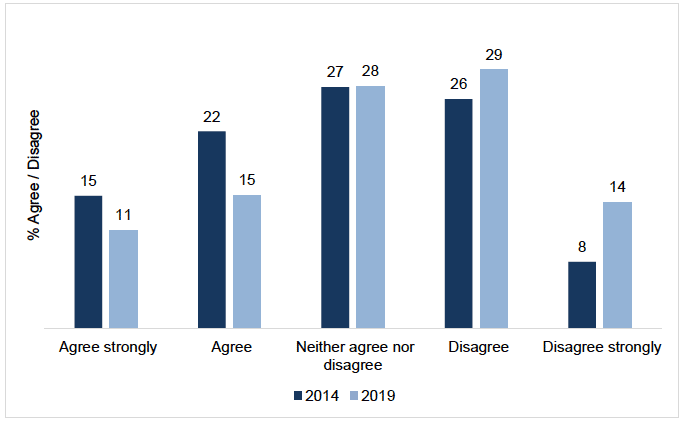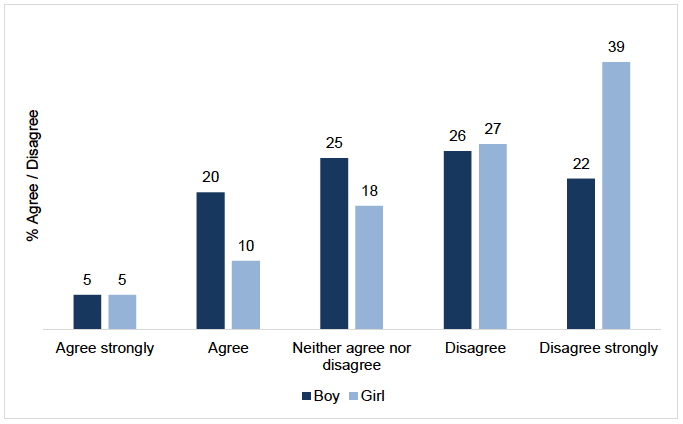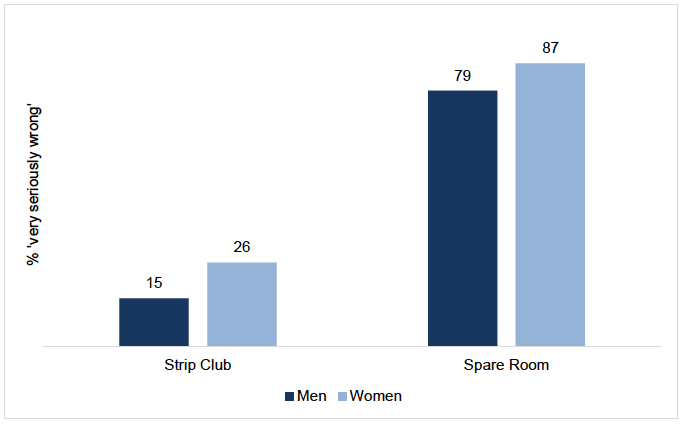Scottish Social Attitudes Survey 2019: attitudes to violence against women
Findings from the 2019 Scottish Social Attitudes Survey on the attitudes of the Scottish public to the following forms of violence against women: sexual violence, domestic abuse (physical, verbal, mental and emotional), sexual harassment and commercial sexual exploitation.
This document is part of 2 collections
Chapter 6 - Commercial sexual exploitation
The final chapter of this report deals with attitudes to different types of commercial sexual exploitation, including prostitution and pornography. Commercial sexual exploitation is included within the broad definition of violence against women adopted by the Scottish Government described in Chapter 1, which ties in with the UN Declaration on the Elimination of Violence Against Women (OCHCR, 1993).
How wrong do people think different types of commercial sexual exploitation are?
All respondents were asked how wrong they thought four different types of commercial sexual exploitation were. In each case the response options were the same, a scale from 1 to 7 where 1 was 'not wrong at all' and 7 was 'very seriously wrong'. The four scenarios were as follows:
'How wrong do you personally think it is for a man (18 or over) to pay for sex with a woman, or is it not wrong at all?'
'How wrong do you personally think it is for an adult (18 or over) to watch pornography at home, or is it not wrong at all?'
'How wrong do you personally think it is for a group of men (18 or over) to go to a strip club to watch naked women, or is it not wrong at all?'
'How wrong do you personally think it is for a man to offer a woman the spare room in his flat in return for sex, or is it not wrong at all?'
The results for each question are shown in Table 6.1.
| Man pays for sex with woman | Adult watches pornography | Men go to strip club | Man offers spare room for sex | |
|---|---|---|---|---|
| (%) | (%) | (%) | (%) | |
| 7 Very seriously wrong | 38 | 20 | 21 | 83 |
| 6 | 13 | 10 | 12 | 7 |
| 5 | 13 | 9 | 15 | 3 |
| 4 | 14 | 11 | 15 | 2 |
| 3 | 7 | 9 | 9 | 1 |
| 2 | 6 | 11 | 10 | * |
| 1 Not wrong at all | 8 | 27 | 17 | 2 |
| Don't know/refused | 2 | 2 | 2 | 1 |
| Weighted base | 964 | 964 | 964 | 964 |
| Unweighted base | 952 | 952 | 952 | 952 |
Base: All respondents who completed the self-completion
The form of commercial sexual exploitation considered to be the most wrong by people in Scotland, by far, is a man offering a woman a spare room in his flat in return for sex, with over four-fifths (83%) considering this to be 'very seriously wrong'. Next most likely (38%) to be considered 'very seriously wrong' is a man paying a woman for sex. Roughly the same proportion of people thought that a group of men going to a strip club (21%) and an adult watching pornography (20%) are 'very seriously wrong'. More people (27%) thought an adult watching pornography was 'not wrong at all' than thought it was 'very seriously wrong' (20%). This was the only form of commercial sexual exploitation where the proportion selecting 'not wrong at all' was higher than the proportion selecting 'very seriously wrong'.
Attitudes towards paying for sex
As well as the question on the perceived wrongness of paying for sex with a woman, three further questions on prostitution were asked. The first question, on the level of harm caused to a woman when a man pays for sex with her, was first asked in 2019; the other two questions were also previously asked in 2014. Respondents were asked:
'Still thinking about a man (18 or over) paying for sex with a woman, what harm, if any, do you think this does to her?'
How much do you agree or disagree that 'Most women who become prostitutes (also known as sex workers) could easily choose a different job if they wanted to.'?
'Do you think it should or should not be against the law for someone to pay for sex?'
Table 6.2 shows the responses to the question on whether people thought that paying for sex with a woman causes harm. Over half (53%) thought that a man paying for sex with a women does her 'a great deal' or 'quite a lot' of harm. Only 12% thought that either 'not very much' or no harm at all is done to the woman.
| % | |
|---|---|
| A great deal | 30 |
| Quite a lot | 24 |
| Some | 31 |
| Not very much | 8 |
| Not at all | 3 |
| Weighted bases | 964 |
| Unweighted bases | 952 |
Base: All respondents who completed the self-completion
In 2019, around a quarter (26%) of people said they either 'agree' or 'strongly agree' that 'most women who become prostitutes could easily choose a different job if they wanted to', with over 2 in 5 (44%) either 'disagreeing' or 'strongly disagreeing' and around 3 in 10 (28%) saying they 'neither agree nor disagree'.
Over half of respondents thought that paying for sex either 'definitely should be' or 'probably should be' against the law (56%), with around two-fifths (41%) saying that paying for sex 'probably should not be' or 'definitely should not be' against the law.[40] Since 2014, there have been no significant changes in views on whether people think it is wrong for a man to pay for sex with a woman, or whether people think that paying for sex should be against the law. In 2014, 34% thought that a man paying for sex with a woman was 'very seriously wrong' compared with 38% in 2019, and 58% in 2014 thought that paying for sex 'definitely' or 'probably' should be against the law (compared with 56% in 2019).
There were, however, significant changes between 2014 and 2019 in views on whether people agreed that 'most women who become prostitues could easily choose a different job if they wanted to'. Figure 6.1 shows that the proportion of people agreeing that prostitutes/sex workers could easily choose a different job if they wanted to has declined by 11 percentage points, from 37% in 2014 to just over a quarter (26%) agreeing with this statement in 2019. The proportion disagreeing increased by 10 percentage points in the same period, from 34% in 2014 to 44% in 2019.
Figure 6.1: 'Most women who become prostitutes (also known as sex workers) could easily choose a different job if they wanted to.' (2014 and 2019, %)

Base: All respondents who completed the self-completion. Those who said 'don't know'/'refused' are not shown.
How do attitudes towards prostitution vary between groups?
Certain groups of people were more likely to think paying for sex is 'very seriously wrong' than others. Those who identified as belonging to a religion were more likely to think that paying for sex is 'very seriously wrong' (50%) than those who had no religious identity (32%). Those who held stereotypical views on gender roles were also more likely to believe paying for sex is 'very seriously wrong' (52%) than those who did not (34%). And those who thought paying for sex is 'very seriously wrong' were more likely (34%) than those who gave it a score of 1 to 6 on the scale (22%) to agree that 'most women who work as prostitutes could easily choose a different job if they wanted to'.
Younger people and those with higher levels of education were less likely to agree that 'most women who work as prostitutes could easily choose a different job if they wanted to'. Just over one-fifth (22%) of those aged between 18 and 34 agreed that 'most women who work as prostitutes could easily choose a different job if they wanted to' compared with nearly 4 in 10 (39%) of those aged 55 to 64 and 3 in 10 (30%) of those aged 65 and over, while one-fifth (20%) of those educated to degree level agreed with the statement compared with around two-fifths (41%) of those with no formal educational qualifications. Those with a higher household income were also less likely to agree with the statement; only 15% of those in the highest income group agreed with the statement compared with 37% of those in the lowest income group. Those who identified as belonging to a religion (35%) were more likely to agree that 'most women who work as prostitutes could easily choose a different job if they wanted to' than those with no religious identity (22%), as were those who held stereotypical views on gender roles (46%) compared with those who did not (19%).[41]
The key difference in responses to the question on what harm people think paying for sex does to a woman was by gender. Women were more likely (60%) than men (47%) to say that paying for sex did either 'a great deal' or 'quite a lot' of harm to the woman. Those who identified as belonging to a religion were also more likely (59%) than those with no religious identity (50%) to think that paying for sex did either a 'great deal' or 'quite a lot' of harm to the woman.[42]
On whether it should be against the law for someone to pay for sex, women were more likely (61%) to think it should be against the law than men (50%). Those who identified as belonging to a religion (65%) were more likely to think it should be against the law than those with no religious identity (51%), while those with stereotypical views on gender roles (63%) were more likely to think it should be illegal than those who did not hold these views (54%).
Attitudes towards pornography
All respondents were asked how wrong they think it is for an adult to watch pornography at home. As shown in Table 6.1 above, more people (27%) thought it was 'not wrong at all' than thought it was 'very seriously wrong' (20%). Half of people (50%) ranked it somewhere between these two points on the scale.
Half of respondents were also asked whether they thought teenage boys aged around 14 or 15 watching pornography was just a normal part of growing up, while the other half were asked the same question about teenage girls. The question asked:
'How much do you agree or disagree with the following statement?
'Teenage boys/girls aged around 14 or 15 watching pornography that shows people having sex (not just actors pretending to do so) is just a normal part of growing up'.'
Figure 6.2 shows that more people agreed that watching pornography 'is just a normal part of growing up' for teenage boys (25%) than agreed that it is for teenage girls (15%). Two-thirds (66%) of people disagreed that watching pornography is a normal part of growing up for teenage girls, while around half (49%) of people disagreed that it is a normal part of growing up for teenage boys.
Figure 6.2: Teenage boys/girls aged around 14/15 watching pornography is just a normal part of growing up (2019, %)

Base: All respondents who completed the self-completion. Those who said 'don't know'/'refused' are not shown.
The question on whether it was wrong for an adult to watch pornography was also asked in 2014. Between 2014 and 2019, although the proportion believing that it is 'wrong' for an adult to watch pornography remained stable, there was an increase in the proportion of people who thought that an adult watching pornography is 'not at all wrong', from 21% in 2014 to 27% in 2019. In 2014, respondents were also asked their views on teenage boys watching pornography. It should be noted that any comparisons between 2014 and 2019 must be caveated, as a similar, but not identical, question was asked about views on whether watching pornography is just 'a normal part of growing up' in 2019.[43] However, while keeping this in mind, between 2014 and 2019, there was an increase in the proportion of people disagreeing that watching pornography is just 'a normal part of growing up' for teenage boys, from 37% in 2014 to 49% in 2019.
How do attitudes towards pornography vary between groups?
Women were more likely (27%) than men (14%) to think that an adult watching pornography was 'very seriously wrong'. While just over 1 in 10 (11%) of those aged between 18 to 34 thought it was 'very seriously wrong', almost 4 in 10 (38%) of those aged 65 and over thought so. Those with a lower level of education and with lower household incomes were more likely to consider watching pornography to be 'very seriously wrong' than their counterparts. Just under one-fifth (18%) of those educated to degree-level thought it was 'very seriously wrong' compared with around a third (31%) of those with no formal qualifications,[44] while 15% of those in the highest household income group thought it 'very seriously wrong' compared with 32% of those in the lowest.[45] As might be expected, those who identified as belonging to a religion (34%) were more likely to believe watching pornography is 'very seriously wrong' than those with no religious identity (13%). Those who held stereotypical views on gender roles were also more likely (32%) to consider an adult watching pornography as 'very seriously wrong' compared with those who did not hold these views (18%).
There were some differences between groups in responses to the questions on whether watching pornography is a normal part of growing up for boys and girls. Men were more likely (30%) than women (20%) to agree that it is a normal part of growing up for teenage boys, though there was no significant difference by gender when the question was asked about teenage girls. Younger people aged 18 to 34 were also more likely (31%) to consider it a normal part of growing up for teenage boys than those aged 65 and over (16%),[46] but again there was no significant difference by age in views on teenage girls watching pornography. Those with no religious identity were more likely (19%) to think that watching pornography is a normal part of growing up for teenage girls than those who did identify as belonging to a religion (9%),[47] while there was no significant difference by religious identity in views about teenage boys.
Other forms of commercial sexual exploitation
SSA 2019 asked two questions on other forms of commercial sexual exploitation in addition to the questions on prostitution and pornography. One of the questions - on the perceived wrongness of a group of men going to a strip club - was also asked in 2014, while the other question - on the perceived wrongness of a man offering a spare room in his flat to a woman in return for sex - was new.
As shown in Table 6.1 above, of all the forms of sexual exploitation listed, offering a spare room in return for sex was the most likely to be viewed as 'very seriously wrong.' Over four-fifths (83%) of people in Scotland thought it to be 'very seriously wrong' compared with around one-fifth (21%) who think a group of men going to a strip club is 'very seriously wrong'. One in fifty (2%) thought a man offering a woman his spare room in return for sex was 'not wrong at all', while 17% classed a group of men going to a strip club in the same way.
Since 2014, there has been an increase in the proportion of people who think that a group of men going to a strip club is 'very seriously wrong'. In 2014, 14% of people thought this was the case; by 2019 this had increased by 7 percentage points to around one-fifth (21%).
How do attitudes towards other forms of commercial sexual exploitation vary between groups?
As shown in Figure 6.3, women were more likely than men to think that going to a strip club is 'very seriously wrong', with around a quarter of women (26%) saying this compared with 15% of men. There were also differences by gender in response to the question on a man offering his spare room to a woman in return for sex, with women being more likely (87%) to say this was 'very seriously wrong' than men (79%).
Older people were also more likely to think going to a strip club is 'very seriously wrong' than their younger counterparts. Around 3 in 10 (29%) of those aged 65 and over said it was 'very seriously wrong' compared with 12% of those aged between 18 and 34. Those with no religious identity were less likely (14%) to say it was 'very seriously wrong' to go to a strip club than those with a religious identity (32%), and those who held stereotypical views on gender roles (30%) were more likely to say it is 'very seriously wrong' than those who did not hold these views (21%).
Figure 6.3: Proportion of people who consider a group of men going to a strip club/ a man offering a woman his spare room in return for sex to be 'very seriously wrong' by gender (2019, %)

Base: All respondents who completed the self-completion
Contact
There is a problem
Thanks for your feedback